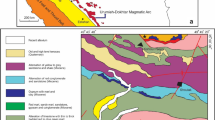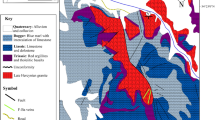Abstract.
The Madjarovo ore district is located in the volcanic rocks of the Oligocene Madjarovo shield volcano and underlying Precambrian(?) and Palaeozoic high-grade metamorphic rocks of the Rhodope Massif, Bulgaria. It is situated in the eastern part of a large Tertiary magmatic–metallogenic belt, which resulted from the Cretaceous collision of Serbo-Macedonian and Rhodope Massifs with the Pelagonian microplate. The low-sulphidation base and precious metal mineralisation at Madjarovo (~32.1 Ma) formed shortly after the cessation of the shoshonitic and high-K calc-alkaline volcanic and intrusive activity (32.6–32.2 Ma), and is spatially and temporally related to late monzonite–trachyte intrusions. The strontium isotope composition of five barite samples hosted in the volcanic sequence is used to characterise the source(s) of Sr in associated base and precious metal mineralisation and to infer fluid fluxes and pathways of the ore-forming fluids. The 87Sr/86Sr compositions for barite samples from ore veins fall in the range 0.70854–0.70955 with the lowest and highest values found in the smaller brecciated veins. Barite from a thin vein in the basal latite lava flow has the most radiogenic 87Sr/86Sr isotope composition, likely reflecting the involvement of more radiogenic metamorphic basement rocks. The least radiogenic composition was determined for barite from a similar vein high in the volcanic pile, 500–600 m above the metamorphic basement. Barites from large veins taken from different stratigraphic positions in the host lavas have almost identical isotopic compositions in the range 0.70883–0.70899. The 87Sr/86Sr values for barite within the deposit are higher than those for host magmatic rocks (0.70775–0.70863), but lower than those of the metamorphic basement (0.7110–0.7278). It is concluded that strontium in the fluids is a mixture of predominantly magmatic strontium and a variable amount of more radiogenic Sr from the metamorphic basement rocks. The ore-bearing fluid may have been derived from a shallow (1–4 km) silicic pluton with an initial 87Sr/86Sr value ~0.7080. Because of the short distance to the site of deposition, the fault-focused ore fluids maintained homogeneous strontium, predominantly magmatic strontium isotope ratios, with slight contribution(s) of more radiogenic strontium from the metamorphic basement rocks. Larger variations in the small brecciated veins can be explained by more extensive fluid–rock interaction with local host metamorphic or volcanic rocks.
Similar content being viewed by others
Author information
Authors and Affiliations
Additional information
Electronic Publication
Rights and permissions
About this article
Cite this article
Marchev, P., Downes, H., Thirlwall, M.F. et al. Small-scale variations of 87Sr/86Sr isotope composition of barite in the Madjarovo low-sulphidation epithermal system, SE Bulgaria: implications for sources of Sr, fluid fluxes and pathways of the ore-forming fluids. Mineralium Deposita 37, 669–677 (2002). https://doi.org/10.1007/s00126-002-0278-3
Received:
Accepted:
Published:
Issue Date:
DOI: https://doi.org/10.1007/s00126-002-0278-3




